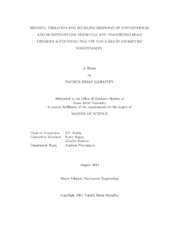| dc.contributor.advisor | Reddy, J. N. | |
| dc.creator | Mahaffey, Patrick Brian | |
| dc.date.accessioned | 2013-12-16T20:13:37Z | |
| dc.date.available | 2013-12-16T20:13:37Z | |
| dc.date.created | 2013-08 | |
| dc.date.issued | 2013-08-07 | |
| dc.date.submitted | August 2013 | |
| dc.identifier.uri | https://hdl.handle.net/1969.1/151319 | |
| dc.description.abstract | Beams are among the most commonly used structural members that are encountered in virtually all systems of structural design at various scales. Mathematical models used to determine the response of beams under external loads are deduced from the three-dimensional elasticity theory through a series of assumptions concerning the kinematics of deformation and constitutive behavior. The kinematic assumptions exploit the fact that such structures do not experience significant trans- verse normal and shear strains and stresses. For example, the solution of the three- dimensional elasticity problem associated with a straight beam is reformulated as a one-dimensional problem in terms of displacements whose form is presumed on the basis of an educated guess concerning the nature of the deformation.
In many cases beam structures are subjected to compressive in-plane loads that may cause out-of-plane buckling of the beam. Typically, before buckling and during compression, the beam develops internal axial force that makes the beam stiffer. In the linear buckling analysis of beams, this internal force is not considered. As a result the buckling loads predicted by the linear analysis are not accurate. The present study is motivated by lack of suitable theory and analysis that considers the nonlinear effects on the buckling response of beams.
This thesis contains three new developments: (1) the conventional beam theories are generalized by accounting for nonlinear terms arising from εzz and εxz that are of the same magnitude as the von K´arm´an nonlinear strains appearing in εxx. The equations of motion associated with the generalized Euler–Bernoulli and Timoshenko beam theories with the von K´arm´an type geometric nonlinear strains are derived using Hamilton’s principle. These equations form the basis of investigations to determine certain microstructural length scales on the bending, vibration and buckling response of beams used in micro- and nano-devices. (2) Analytical solutions of the conventional Timoshenko beam theory with the von K´arm´an nonlinearity are de- veloped for the case where the inplane inertia is negligible when compared to other terms in the equations of motion. Numerical results are presented to bring out the effect of transverse shear deformation on the buckling response. (3) The development of a nonlinear finite element model for post-buckling behavior of beams. | en |
| dc.format.mimetype | application/pdf | |
| dc.language.iso | en | |
| dc.subject | Analytical solutions | en |
| dc.subject | coupled system of equations | en |
| dc.subject | buckling loads | en |
| dc.subject | generalized nonlinear theories
of beams | en |
| dc.subject | microstructural length scales | en |
| dc.subject | von Kármán geometric nonlinear strains. | en |
| dc.title | Bending, Vibration and Buckling Response of Conventional and Modified Euler-Bernoulli and Timoshenko Beam Theories Accounting for the von Karman Geometric Nonlinearity | en |
| dc.type | Thesis | en |
| thesis.degree.department | Mechanical Engineering | en |
| thesis.degree.discipline | Mechanical Engineering | en |
| thesis.degree.grantor | Texas A & M University | en |
| thesis.degree.name | Master of Science | en |
| thesis.degree.level | Masters | en |
| dc.contributor.committeeMember | Hogan, Harry | |
| dc.contributor.committeeMember | Radovic, Miladin | |
| dc.type.material | text | en |
| dc.date.updated | 2013-12-16T20:13:38Z | |


